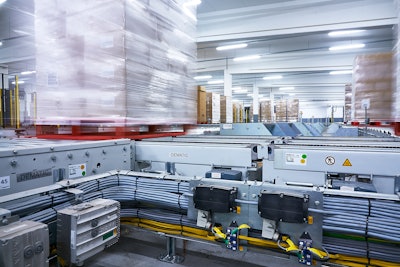
Digitalizing the supply chain is the future. But, getting there takes automation and emerging technology. It requires investing in solutions designed to track and trace, produce data analytics and deliver real-time alerts when parts of the supply chain fall off track. It requires buy-in from all decision-makers to help build the supply chain of tomorrow.
And, it’s this automation and emerging technology that helps the cold food chain build the supply chain of tomorrow.
In Food Logistics’ March/April 2022 issue, editor-in-chief Marina Mayer talks with several industry experts about warehouse automation and how automation and emerging technology future-proof supply chains.
Here’s an interview with Tom Swovick, market development director, Dematic, who details the importance of automation, with excerpts publishing in Food Logistics’ March/April 2022 issue. [CLICK HERE to read the article in full].
Food Logistics: From your perspective, what are some of the top challenges today’s cold food chains face?
Tom Swovick: Labor is the most pressing issue. Cold chain environments have always been one of the less attractive work environments due to low operating temperatures and multi-shift operations.
The current labor shortage has been amplified in cold chains. Additionally, many existing sites are aging, located in the wrong area, and not energy efficient. While there is a high interest in automation, current supply chain challenges have increased the timeline for implementation.
Lastly, many of the existing manual operations are not very automated.
Food Logistics: And, how can warehouse automation help overcome these challenges?
Swovick: One of the fundamental needs for a cold chain is to minimize building size, as refrigerated space is expensive to maintain and very costly to build. A growing expectation of refrigerated public warehouses is fulfilling orders on a more granular basis, frequently at a mixed case level. We have developed the end-to-end Dematic Mixed Case Fulfillment Solution, which automates all facets of the order fulfillment process from inbound receiving to outbound shipping. The system allows users to reduce picking labor and rapidly build high-density, store-ready pallets and carts. It does so in a building footprint that is unrivaled in the industry from a space efficiency perspective. It provides accurate, aisle-friendly pallets with a fraction of the labor.
Food Logistics: The warehouse automation market is expected to grow to $27 billion by 2025; twice the size it was roughly five years ago, according to Research and Markets. To what do you attribute this growth to?
Swovick: A confluence of factors leads us to unprecedented demand for warehouse automation.
The labor shortage is a significant contributor to which the baby boomers are a factor. Soon we will see the inverse of the stagflation from the late 1970s when an unprecedented number of new workers entered the workforce.
Adding to the labor shortage is the need to provide consumers with convenience – something that e-commerce provides. Growth in e-commerce fuels automation demand, as well as warehouse space for that automation.
The demand for warehouse space drives up the price of land and warehouses themselves. This, in turn, has suppliers wanting to maximize their current space and focus on cubic efficiency. This combination drives warehouses vertical, increasing the demand for vertical storage automation, resulting in fewer fork trucks operating in a 30-foot-high warehouse and more automation operating in a 140-foot-high warehouse.
Food Logistics: There are many different types of automated warehousing solutions. What kinds of emerging warehouse automation technologies do you see continuing to make an impact on the industry?
Swovick: Though a loaded question, the obvious answer is anything associated with e-commerce or flexible technology that doesn’t need to be bolted to the floor. AMRs will undoubtedly be a huge growth area.
Urbanization coupled with short delivery times and limited labor availability bodes well for flexible technologies which have higher throughput ceilings than many traditional automation solutions. Though more flexible, it also depends upon the handling unit of measure. For some portions of our supply chain, pallets will be the preferred handling unit ad-infinitum. For those instances, the aforementioned pallet shuttle technology holds much promise.
Food Logistics: What advice do you have for those companies still struggling to adopt warehouse automation? Where do you envision the hang-ups being and why?
Swovick: Automation is no longer a brave new frontier, it’s proven, and it works. With that fundamental thought in mind eliminating hang-ups starts with the basics. The age-old adage of “don’t automate a bad process.” A sage mentor early in my career taught me that if the solution is too complicated, step back and take a more holistic view. The next piece of advice comes from Ernst Young – forward-thinking companies are looking at 7- to 10-year timeframes to justify automation; they are including HR in the discussion early and often and with that getting a clearer picture of the true cost of bringing in a new employee; they are using automation as a recruiting tool to help attract the best talent.
When you get past the business essentials, you must look at the materials to be handled. Understand those and make certain the mechatronics applied are robust enough to handle the complete range of entities. When those activities are complete, you must complete some due diligence regarding the “most bang for the buck.” If 5% of the need drives 30, 40 or a greater percentage of the cost, look for an alternate solution for the 5% and reap the benefits for 95%. All these recommendations boil down to one simple Steven Covey phrase, “think deeply in sustained ways.”
Make sure you have a good plan to maintain the system whether that be a service contract with your solution provider or your own well-trained employees.
Lastly, find a proven solution partner that you can trust. Work closely and collaboratively, while establishing a healthy, open two-way dialog.
[CLICK HERE to read the article in full].




















